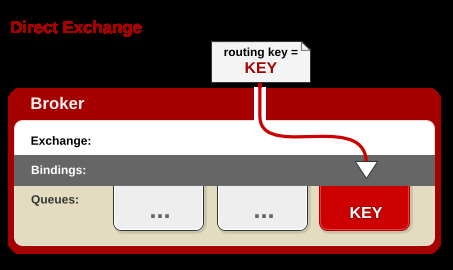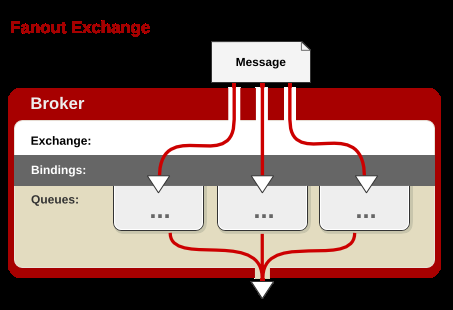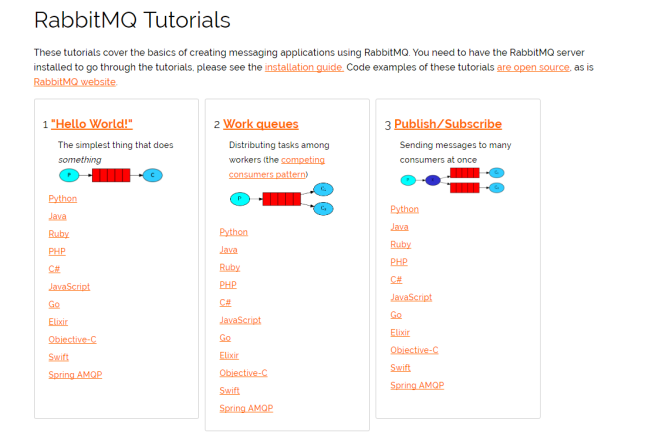1.pom.xml添加依赖

<!--RabbitMq--> <dependency> <groupId>org.springframework.boot</groupId> <artifactId>spring-boot-starter-test</artifactId> <scope>test</scope> </dependency> <dependency> <groupId>org.springframework.boot</groupId> <artifactId>spring-boot-starter-amqp</artifactId> </dependency>
2.application.yml

spring: application: admin: springboot-rabbitmq rabbitmq: host: localhost port: 5672 username: guest password: guest publisher-returns: true listener: direct: acknowledge-mode: manual simple: acknowledge-mode: manual
3.添加配置类RabbitMqConfig

@Configuration public class RabbitMqConfig { @Autowired public ConnectionFactory connectionFactory; @Bean public RabbitAdmin rabbitAdmin() { RabbitAdmin admin = new RabbitAdmin(connectionFactory); return admin; } @Bean public Queue kinsonQueue(){//创建队列 Map<String, Object> arguments = new HashMap<>(); arguments.put("x-message-ttl", 40000); return new Queue("queue1",true,false,false,arguments); } @Bean public FanoutExchange defaultExchange(){//创建交换机 return new FanoutExchange("exchange-1"); } @Bean public Binding binQueueExchange(){//队列绑定交换机 return BindingBuilder.bind(kinsonQueue()).to(defaultExchange()); } }
4.添加生产者

@Component public class RabbitSender { @Autowired private RabbitTemplate rabbitTemplate; private final Logger log = LoggerFactory.getLogger(this.getClass()); //回调函数: confirm确认 final RabbitTemplate.ConfirmCallback confirmCallback = new RabbitTemplate.ConfirmCallback() { @Override public void confirm(CorrelationData correlationData, boolean ack, String cause) { log.info("correlationData: " + correlationData); log.info("ack: " + ack); if (!ack) { log.info("异常处理...."); } } }; //回调函数: return返回 final RabbitTemplate.ReturnCallback returnCallback = new RabbitTemplate.ReturnCallback() { @Override public void returnedMessage(org.springframework.amqp.core.Message message, int replyCode, String replyText, String exchange, String routingKey) { log.info("return exchange: {}, routingKey: {}, replyCode: {}, replyText: {}", exchange, routingKey, replyCode, replyText); } }; //发送消息方法调用: 构建Message消息 public void send(String queue, Map<String, Object> properties) throws Exception { MessageHeaders mhs = new MessageHeaders(properties); Message<Object> msg = MessageBuilder.createMessage("queue1", mhs); rabbitTemplate.setConfirmCallback(confirmCallback); rabbitTemplate.setReturnCallback(returnCallback); rabbitTemplate.convertAndSend(queue, msg); } }
5.添加消费者

@Component public class RabbitReceiver { @RabbitListener(queues = "queue1") @RabbitHandler public void onMessage(Message message, Channel channel,@Payload String string) throws Exception { Long deliveryTag = (Long)message.getHeaders().get(AmqpHeaders.DELIVERY_TAG); // 手工ACK channel.basicAck(deliveryTag, false); System.err.println("消费端: " +message); } }
6.测试

@SpringBootTest class DemoApplicationTests { @Autowired private RabbitSender rabbitSender; private static SimpleDateFormat simpleDateFormat = new SimpleDateFormat("yyyy-MM-dd HH:mm:ss.SSS"); @Test public void testSender1() throws Exception { Map<String, Object> properties = new HashMap<>(); properties.put("number", "12345"); properties.put("send_time", simpleDateFormat.format(new Date())); rabbitSender.send("queue1", properties); } }
RabbitMQ介绍:
1.交换机:
Direct Exchange(直连交换机)
处理路由键
需要将一个队列绑定到交换机上,要求该消息与一个特定的路由键完全匹配。这是一个完整的匹配。如果一个队列
绑定到该交换机上要求路由键 “ dog”,则只有被标记为 “ 的消息才被转发,不会转发 dog.puppy ,也不会转发dog.guard ,只会转发 dog 。

Fanout Exchange(扇型交换机)
不处理路由键
你只需要将队列绑定到交换机上, 发送消息 到交换机都会被转发到与该交换机绑定的所有队列上。

Topic Exchange(主题交换机)
将路由键和某模式进行匹配
此时队列需要绑定要一个模式上。符号“#”匹配一个或多个词,符号“*”匹配一个词。因此“audit.#”能够匹配到“audit.irs.corporate”,但是“audit.*” 只会匹配到“audit.irs”。

Headers Exchanges(头交换机)
不处理路由键
而是根据发送的消息内容中的headers属性进行匹配。在绑定Queue与Exchange时指定一组键值对;当消息发送到RabbitMQ时会取到该消息的headers与Exchange绑定时指定的键值对进行匹配;如果完全匹配则消息会路由到该队列,否则不会路由到该队列。headers属性是一个键值对,可以是Hashtable,键值对的值可以是任何类型。而fanout,direct,topic 的路由键都需要要字符串形式的。
Default Exchange(默认交换机 )
默认交换机实际上是一个由RabbitMQ预先声明好的名字为空字符串的直连交换机(direct exchange)。它有一个特殊的属性使得它对于简单应用特别有用处:那就是每个新建队列(queue)都会自动绑定到默认交换机上,绑定的路由键(routing key)名称与队列名称相同。
Dead Letter Exchange(死信交换机)
在默认情况,如果消息在投递到交换机时,交换机发现此消息没有匹配的队列,则这个消息将被丢弃。为了解决这个问题,RabbitMQ中有一种交换机叫死信交换机。当消费者不能处理接收到的消息时,将这个消息重新发布到另外一个队列中,等待重试或者人工干预。这个过程中的exchange和queue就是所谓的”Dead Letter Exchange 和 Queue”
交换机的属性:
Name:交换机名称
Durability:是否持久化。如果持久性,则RabbitMQ重启后,交换机还存在
Auto-delete:当所有与之绑定的消息队列都完成了对此交换机的使用后删掉它
Arguments:扩展参数
2.六种消息类型
官网 http://www.rabbitmq.com/getstarted.html


3.RabbitMQ配置属性
参考资料: https://docs.spring.io/spring-boot/docs/current/reference/html/common-application-properties.html
基础信息
spring.rabbitmq.host: 默认localhost spring.rabbitmq.port: 默认5672 spring.rabbitmq.username: 用户名 spring.rabbitmq.password: 密码 spring.rabbitmq.virtual-host: 连接到代理时用的虚拟主机 spring.rabbitmq.addresses: 连接到server的地址列表(以逗号分隔),先addresses后host spring.rabbitmq.requested-heartbeat: 请求心跳超时时间,0为不指定,如果不指定时间单位默认为妙 spring.rabbitmq.publisher-confirms: 是否启用【发布确认】,默认false spring.rabbitmq.publisher-returns: 是否启用【发布返回】,默认false spring.rabbitmq.connection-timeout: 连接超时时间,单位毫秒,0表示永不超时
